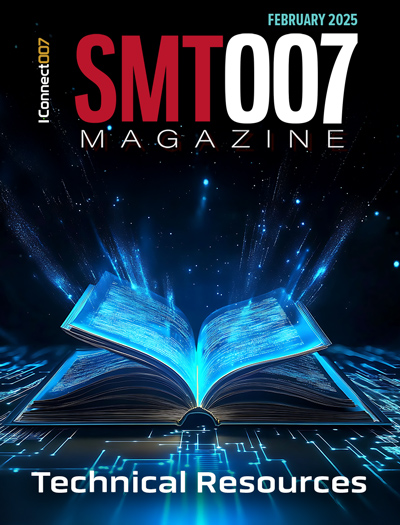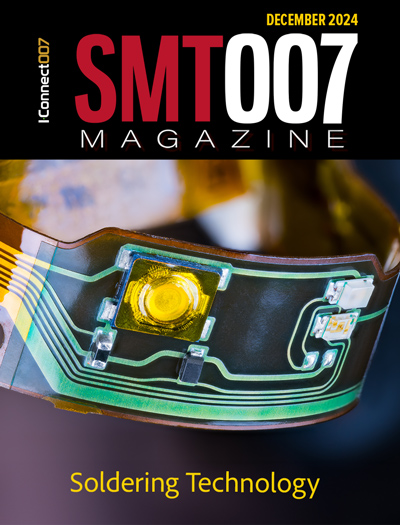-

- News
- Books
Featured Books
- smt007 Magazine
Latest Issues
Current Issue
Technical Resources
Key industry organizations–all with knowledge sharing as a part of their mission–share their technical repositories in this issue of SMT007 Magazine. Where can you find information critical to your work? Odds are, right here.

The Path Ahead
What are you paying the most attention to as we enter 2025? Find out what we learned when we asked that question. Join us as we explore five main themes in the new year.

Soldering Technologies
Soldering is the heartbeat of assembly, and new developments are taking place to match the rest of the innovation in electronics. There are tried-and-true technologies for soldering. But new challenges in packaging, materials, and sustainability may be putting this key step in flux.
- Articles
- Columns
Search Console
- Links
- Media kit
||| MENU - smt007 Magazine
Proposed IEC Standard on Halogen-Free Raises Concerns
July 10, 2017 | IPCEstimated reading time: 1 minute
Like the game Whack-a-Mole, the idea of a standard for low-halogen electronics keeps popping up. Originally, proposed as an IPC specification of chlorine and bromine in copper-clad laminates, IEC 61249-2-21 was established many years ago to define FR-4 products for halogen-free.
Then about a decade ago, concerns about certain toxic bromine-containing flame-retardants (polybrominated biphenyls (PBBs) and polybrominated diphenyl ethers (PBDEs) and concerns regarding incomplete combustion of PVC and bromine-containing plastics in electronics led to the passage of the EU WEEE Regulation and RoHS Directive which banned the toxic substances and mandated appropriate handling of waste electronics.
Despite the removal of any toxic halogen-containing compounds from the electronics supply chain, IPC and JEDEC members began discussions about the development of a standard for low halogen electronics. IPC, with its broad membership and open voting processes, never approved the low halogen standard, which was deemed to be a marketing tool posing as an environmental standard. JEDEC, with its narrower membership, went ahead and passed and published "Definition of 'Low Halogen' for Electronic Products” in 2015.
In 2016, the JEDEC standard was temporarily (up to six years) approved by IEC TC 111 (environmental standardization committee) as an IEC publicly available specification (PAS), despite the broad questions that were raised regarding technical validity. Revision and permanent adoption of the standard is now being considered by TC 111. The proposed revision would define electronics as “Low Halogen” when they “contain less than 0,9% (by mass) total elemental halogen content (F+Cl+Br+I) and meet the thresholds of all halogenated substances in IEC 91 62474 database." The proposed standard is concerning not just because of the content of the proposal, but by the labeling of low halogen as an environmental standard.
The standard is in the Committee Draft Phase which means it is being circulated for comments to all IEC TC111 member countries. The deadline for comment is September 15, 2017. If you are concerned, contact your country’s IEC National Committee and the IEC TC111 representatives.
Suggested Items
Federal Electronics Expands Mexico Operations
02/26/2025 | Federal ElectronicsFederal Electronics, a leader in providing advanced electronic manufacturing services, has expanded its Hermosillo, Sonora, Mexico facility from 30,000 square feet to over 80,000 square feet to support growing customer demand and further increase vertical integration in the region.
The Knowledge Base: Challenges and Considerations of Harsh Environments
02/26/2025 | Mike Konrad -- Column: The Knowledge BaseIn today’s rapidly advancing technological landscape, electronic assemblies are increasingly being deployed into environments that push their design and material limits. From the corrosive atmospheres of industrial facilities to the extreme temperatures and humidity of outdoor applications, harsh environments present a significant challenge to the reliability of electronic devices. This column explores the key issues impacting electronics reliability in such conditions, including electrochemical migration (ECM), corrosion, and the role of residue tolerance in assembly design.
Beyond the Board: The Future of Innovation—Why the Electronics Industry Needs You
02/25/2025 | Jesse Vaughan -- Column: Beyond the BoardWith new challenges and opportunities on the horizon, now is the perfect time for the younger generation to step up, learn, and get involved. This is a call to action for those ready to make an impact, as the future of electronics is in their heads and more importantly, their hands.
2024 Sustainability Highlights: IPC’s Commitment to a Greener Future
02/25/2025 | Kelly Scanlon, IPCIn 2024, IPC’s Sustainability for Electronics program made significant impacts through multiple channels of engagement by providing the industry with insights and tools needed to build electronics better. IPC representatives shared expertise at industry events, demonstrating how standards, education, and advocacy support sustainability goals. Industry leaders reciprocated by presenting their successful sustainability initiatives at IPC events, offering valuable real-world perspectives on implementing sustainable practices.
IPC APEX EXPO Named One of Trade Show Executive’s Top 100, Class of 2024
02/24/2025 | IPCTrade Show Executive, the foremost magazine for the trade show industry, recognized IPC APEX EXPO 2024 as one of the top 100 fastest-growing trade shows in the United States for the number of exhibiting companies and net square footage.


